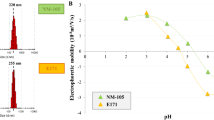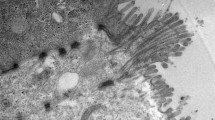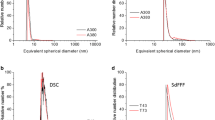Abstract
Bulk- and nano-scale titanium dioxide (TiO2) has found use in human food products for controlling color, texture, and moisture. Once ingested, and because of their small size, nano-scale TiO2 can interact with a number of epithelia that line the human gastrointestinal tract. One such epithelium responsible for nutrient absorption is the small intestine, whose constituent cells contain microvilli to increase the total surface area of the gut. Using a combination of scanning and transmission electron microscopy it was found that food grade TiO2 (E171 food additive coded) included ∼25 % of the TiO2 as nanoparticles (NPs; <100 nm), and disrupted the normal organization of the microvilli as a consequence of TiO2 sedimentation. It was found that TiO2 isolated from the candy coating of chewing gum and a commercially available TiO2 food grade additive samples were of the anatase crystal structure. Exposure to food grade TiO2 additives, containing nanoparticles, at the lowest concentration tested within this experimental paradigm to date at 350 ng/mL (i.e., 100 ng/cm2 cell surface area) resulted in disruption of the brush border. Through the use of two independent techniques to remove the effects of gravity, and subsequent TiO2 sedimentation, it was found that disruption of the microvilli was independent of sedimentation. These data indicate that food grade TiO2 exposure resulted in the loss of microvilli from the Caco-2BBe1 cell system due to a biological response, and not simply a physical artifact of in vitro exposure.











Similar content being viewed by others
Abbreviations
- BBe1:
-
Brush border expressing 1
- ICP-MS:
-
Inductively coupled plasma mass spectroscopy
References
APHA, AWWA & WEF 2005. Standard Methods for the Examination of Water and Wastewater.
Bachman BJ, Vasile MJ. Ion bombardment of polyimide films. J Vac Sci Technol A Vac Surf Films. 1989;7:2709–16.
Begg DA, Rodewald R, Rebhun LI. The visualization of actin filament polarity in thin sections. Evidence for the uniform polarity of membrane-associated filaments. J Cell Biol. 1978;79:846–52.
Bement WM, Mooseker MS. The cytoskeleton of the intestinal epithelium: components, assembly, and dynamic rearrangements. Cytoskeleton Multi-Vol treat. 1996;3:359–404.
Bretscher A. Microfilament organization in the cytoskeleton of the intestinal brush border. Cell Muscle Motil. 1983;4:239.
Bretscher A, Weber K. Fimbrin, a new microfilament-associated protein present in microvilli and other cell surface structures. J Cell Biol. 1980a;86:335–40.
Bretscher A, Weber K. Villin is a major protein of the microvillus cystoskeleton which binds both G and F actin in a calcium-dependent manner. Cell. 1980b;20:839–47.
Cho EC, Zhang Q, Xia Y. The effect of sedimentation and diffusion on cellular uptake of gold nanoparticles. Nat Nanotechnol. 2011;6:385–91.
Clark D, Thomas H. Applications of ESCA to polymer chemistry. XVII Systematic investigation of the core levels of simple homopolymers. J Polym Sci Polym Chem Ed. 1978;16:791–820.
Delpeux S, Beguin F, Benoit R, Erre R, Manolova N, Rashkov I. Fullerene core star-like polymers—1. Preparation from fullerenes and monoazidopolyethers. Eur Polym J. 1998;34:905–15.
De Beauregard MC, Pringault E, Robine S, Louvard D. Suppression of villin expression by antisense RNA impairs brush border assembly in polarized epithelial intestinal cells. EMBO J. 1995;14:409.
Demri B, Muster D. XPS study of some calcium compounds. J Mater Process Technol. 1995;55:311–4.
Duan Y, Liu J, Ma L, Li N, Liu H, Wang J, et al. Toxicological characteristics of nanoparticulate anatase titanium dioxide in mice. Biomaterials. 2010;31:894–9.
Dunphy Guzman KA, Taylor MR, Banfield JF. Environmental risks of nanotechnology: National nanotechnology initiative funding, 2000–2004. Environ Sci Technol. 2006;40:1401–7.
Faust JJ, Masserano BM, Mielke AH, Abraham A, Capco DG. Engineered nanoparticles induced brush border disruption in a human model of the intestinal epithelium. Nanomaterial. Springer; 2014a.
Faust JJ, Zhang W, Chen Y, Capco DG. Alpha-Fe2O3 elicits diameter-dependent effects during exposure to an in vitro model of the human placenta. Cell Biol Toxicol. 2014b;1–23.
Ferrary E, Cohen-Tannoudji M, Pehau-Arnaudet G, Lapillonne A, Athman R, Ruiz T, et al. In vivo, villin is required for Ca2+-dependent F-actin disruption in intestinal brush borders. J Cell Biol. 1999;146:819–30.
Fröhlich E, Roblegg E. Models for oral uptake of nanoparticles in consumer products. Toxicology. 2012;291:10–7.
Gardner SD, Singamsetty CS, Booth GL, He G-R, Pittman CU. Surface characterization of carbon fibers using angle-resolved XPS and ISS. Carbon. 1995;33:587–95.
Grimm-Günter E-M, Revenu C, Ramos S, Hurbain I, Smyth N, Ferrary E, et al. Plastin 1 binds to keratin and is required for terminal web assembly in the intestinal epithelium. Mol Biol Cell. 2009;20:2549–62.
Heintzelman MB, Mooseker MS. Assembly of the intestinal brush border cytoskeleton. Curr Top Dev Biol. 1992;26:93–122.
Hirokawa N, Cheney RE, Willard M. Location of a protein of the fodrin-spectrin-TW260/240 family in the mouse intestinal brush border. Cell. 1983;32:953–65.
Hirokawa N, Heuser JE. Quick-freeze, deep-etch visualization of the cytoskeleton beneath surface differentiations of intestinal epithelial cells. J Cell Biol. 1981;91:399–409.
Hirokawa N, Tilney LG, Fujiwara K, Heuser JE. Organization of actin, myosin, and intermediate filaments in the brush border of intestinal epithelial cells. J Cell Biol. 1982;94:425–43.
Howe CL, Mooseker MS. Characterization of the 110-kdalton actin-calmodulin-, and membrane-binding protein from microvilli of intestinal epithelial cells. J Cell Biol. 1983;97:974–85.
Hu R, Gong X, Duan Y, Li N, Che Y, Cui Y, et al. Neurotoxicological effects and the impairment of spatial recognition memory in mice caused by exposure to TiO2 nanoparticles. Biomaterials. 2010;31:8043–50.
Ishikawa H, Bischoff R, Holtzer H. Formation of arrowhead complexes with heavy meromyosin in a variety of cell types. J Cell Biol. 1969;43:312–28.
Jouan P-Y, Peignon M-C, Cardinaud C, Lemperiere G. Characterisation of TiN coatings and of the TiN/Si interface by X-ray photoelectron spectroscopy and Auger electron spectroscopy. Appl Surf Sci. 1993;68:595–603.
Kalive M, Zhang W, Chen Y, Capco DG. Human intestinal epithelial cells exhibit a cellular response indicating a potential toxicity upon exposure to hematite nanoparticles. Cell Biol Toxicol. 2012;28:343–68.
Koeneman BA, Zhang Y, Westerhoff P, Chen Y, Crittenden JC, Capco DG. Toxicity and cellular responses of intestinal cells exposed to titanium dioxide. Cell Biol Toxicol. 2010;26:225–38.
Lesniak A, Fenaroli F, MONOPOLI MP, Åberg C, DAWSON KA, Salvati A. Effects of the presence or absence of a protein corona on silica nanoparticle uptake and impact on cells. ACS Nano. 2012;6:5845–57.
Lundqvist M, Stigler J, Elia G, Lynch I, Cedervall T, Dawson KA. Nanoparticle size and surface properties determine the protein corona with possible implications for biological impacts. Proc Natl Acad Sci. 2008;105:14265–70.
Milani S, Baldelli Bombelli F, Pitek AS, Dawson KA, Rädler J. Reversible versus irreversible binding of transferrin to polystyrene nanoparticles: soft and hard corona. ACS Nano. 2012;6:2532–41.
Mooseker MS. Organization, chemistry, and assembly of the cytoskeletal apparatus of the intestinal brush border. Annu Rev Cell Biol. 1985;1:209–41.
Mukherjee T, Staehelin L. The fine-structural organization of the brush border of intestinal epithelial cells. J Cell Sci. 1971;8:573–99.
Oberdörster G, Maynard A, Donaldson K, Castranova V, Fitzpatrick J, Ausman K, et al. Principles for characterizing the potential human health effects from exposure to nanomaterials: elements of a screening strategy. Part Fibre Toxicol. 2005;2:8.
OECD 1994. OECD Guidelines for the Testing of Chemicals, Organization for Economic.
Patterson A. The Scherrer formula for X-ray particle size determination. Phys Rev. 1939;56:978.
Peterson M, Mooseker M. Characterization of the enterocyte-like brush border cytoskeleton of the C2BBe clones of the human intestinal cell line, Caco-2. J Cell Sci. 1992;102:581–600.
Peterson MD, Bement WM, Mooseker MS. An in vitro model for the analysis of intestinal brush border assembly. II. Changes in expression and localization of brush border proteins during cell contact-induced brush border assembly in Caco-2BBe cells. J Cell Sci. 1993;105:461–72.
Peterson MD, Mooseker MS. An in vitro model for the analysis of intestinal brush border assembly. I. Ultrastructural analysis of cell contact-induced brush border assembly in Caco-2BBe cells. J Cell Sci. 1993;105:445–60.
Powell JJ, Faria N, Thomas-Mckay E, Pele LC. Origin and fate of dietary nanoparticles and microparticles in the gastrointestinal tract. J Autoimmun. 2010;34:J226–33.
Regulations CF. Title 21. Chapter I (revised). 2000;
Revenu C, Ubelmann F, Hurbain I, El-Marjou F, Dingli F, Loew D, et al. A new role for the architecture of microvillar actin bundles in apical retention of membrane proteins. Mol Biol Cell. 2012;23:324–36.
Schwarz RP, Wolf DA. Rotating bio-reactor cell culture apparatus. 1991;
Shih P, Yung S, Chin T. Thermal and corrosion behavior of P2O5−Na2O–CuO glasses. J Non-Cryst Solids. 1998;224:143–52.
Stidwill RP, Wysolmerski T, Burgess DR. The brush border cytoskeleton is not static: in vivo turnover of proteins. J Cell Biol. 1984;98:641–5.
Tanuma S, Powell CJ, Penn DR. Calculations of electron inelastic mean free paths. V. Data for 14 organic compounds over the 50–2000eV range. Surf Interface Anal. 1994;21:165–76.
Tilney LG, Mooseker M. Actin in the brush-border of epithelial cells of the chicken intestine. Proc Natl Acad Sc. 1971;68:2611–5.
Van Der Flier LG, Clevers H. Stem cells, self-renewal, and differentiation in the intestinal epithelium. Annu Rev Physiol. 2009;71:241–60.
Wang J, Zhou G, Chen C, Yu H, Wang T, Ma Y, et al. Acute toxicity and biodistribution of different sized titanium dioxide particles in mice after oral administration. Toxicol Lett. 2007;168:176–85.
Warheit DB, Hoke RA, Finlay C, Donner EM, Reed KL, Sayes CM. Development of a base set of toxicity tests using ultrafine TiO2 particles as a component of nanoparticle risk management. Toxicol Lett. 2007;171:99–110.
Weir A, Westerhoff P, Fabricius L, Hristovski K, Von Goetz N. Titanium dioxide nanoparticles in food and personal care products. Environ Sci Technol. 2012;46:2242–50.
Weng L, Poleunis C, Bertrand P, Carlier V, Sclavons M, Franquinet P, et al. Sizing removal and functionalization of the carbon fiber surface studied by combined TOF SIMS and XPS. J Adhes Sci Technol. 1995;9:859–71.
Yang Y, Doudrick K, Bi X, Hristovski K, Herckes P, Westerhoff P, Kaegi R. Characterization of food-grade titanium dioxide: presence of nano-size particles. Environ Sci Technol. 2014. doi:10.1021/es500436x.
Zhang W, Kalive M, Capco DG, Chen Y. Adsorption of hematite nanoparticles onto Caco-2 cells and the cellular impairments: effect of particle size. Nanotechnology. 2010;21:355103.
Acknowledgements
The authors thank Mr. Xiangyu Bi for conducting ICP-MS on the TiO2 samples. We wish to thank David Lowry for his assistance in the W.M. Keck Bioimaging Facility at ASU. The authors thank Dr. Karen Sweazea for the use of Sigma Stat version 3.5 software used for multiple comparisons.
Conflict of interest
The authors declare no competing interest. Funding was provided by an NSF award (CBET 1336542) to P.W.
Author information
Authors and Affiliations
Corresponding author
Electronic supplementary material
Below is the link to the electronic supplementary material.
Supplemental Fig. 1
XPS K 2p spectra of gum TiO2. (PNG 98 kb)
Supplemental Fig. 2
XPS wide scan for food grade TiO2. (PNG 137 kb)
Supplemental Fig. 3
XPS wide scan for gum TiO2. (PNG 145 kb)
Supplemental Fig. 4
XPS C 1s spectra of gum TiO2 (PNG 247 kb)
(AVI 2679 kb)
(AVI 6601 kb)
(AVI 12147 kb)
Rights and permissions
About this article
Cite this article
Faust, J.J., Doudrick, K., Yang, Y. et al. Food grade titanium dioxide disrupts intestinal brush border microvilli in vitro independent of sedimentation. Cell Biol Toxicol 30, 169–188 (2014). https://doi.org/10.1007/s10565-014-9278-1
Received:
Accepted:
Published:
Issue Date:
DOI: https://doi.org/10.1007/s10565-014-9278-1




